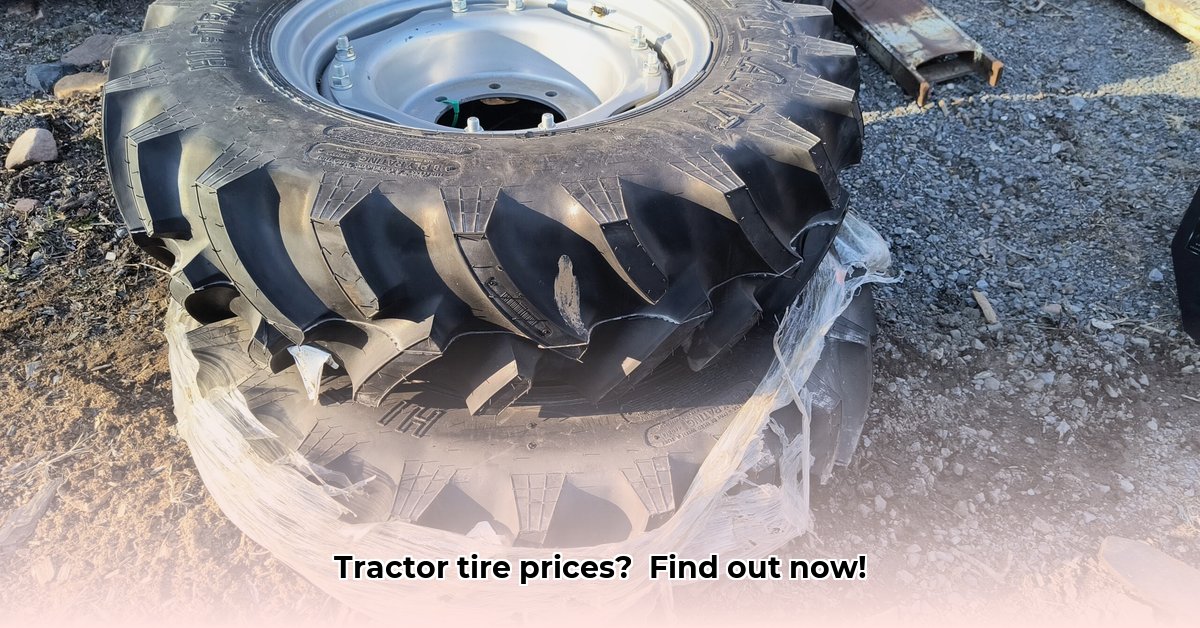
Ever wondered about the true cost of a tractor tire? It's a bigger question than you might think, with prices ranging dramatically from roughly $400 to over $2,900. This guide will help you navigate the complexities of tractor tire costs, providing actionable advice to maximize your investment and minimize expenses. We'll explore factors influencing price, calculate the total cost of ownership (TCO), and offer practical maintenance tips to extend tire lifespan. Let's get started! For tire size references, check out this helpful tire size chart.
Understanding What Drives Tractor Tire Prices
Several key factors influence the price you pay for tractor tires. Understanding these will help you make informed purchasing decisions that save you money in the long run.
Tire Size and Type: The Right Tool for the Job
Tractor tires aren't one-size-fits-all. Different applications require different tire types:
R1 Tires: These workhorses are designed for maximum traction in fields, offering superior grip and longevity. Expect higher upfront costs, but their extended lifespan often makes them the most economical option over time.
R3 Tires: Better suited for turf applications like lawns and manicured areas, these tires prioritize ground protection over aggressive traction. They usually represent a balance between cost and performance.
R4 Tires: Built for rough terrain and construction sites, these heavy-duty tires can handle extreme conditions. Their robust construction leads to a higher initial cost.
Tire size also influences price; larger tires generally cost more. Choosing the correct size and type for your specific needs is critical for both performance and cost-effectiveness. Do your homework to select the tire that best fits your work profile.
Brand and Quality: Investing in Reliability
Just like with any equipment, brand reputation matters. Established brands often command premium prices due to their reputation for quality and durability. However, there are many reliable, less expensive brands available that offer a good balance of performance and cost. Thorough research, considering reviews and recommendations from other farmers, is essential.
New vs. Used Tires: A Calculated Risk
Buying used tires offers the potential for significant upfront savings. But, there's a gamble involved. Used tires may have hidden damage, leading to premature failure and costly downtime. A thorough inspection is crucial before purchasing used tires. We'll cover tire inspection techniques in a later section.
Calculating the Total Cost of Ownership (TCO)
The initial purchase price isn't the entire story. To make a truly informed decision, calculate the TCO, which incorporates several key factors:
- Initial Cost: The upfront purchase cost of the tire.
- Lifespan: The expected operational life of the tire, significantly influenced by tire type, usage, and maintenance.
- Maintenance Costs: Costs associated with regular inspections, pressure checks, repairs, and potential replacements.
- Downtime Costs: The financial impact of lost productivity due to tire failures or unexpected repairs.
Example: A cheaper tire might initially save you $500, but if it wears out twice as fast as a more expensive option, this initial saving may disappear quickly when factoring in replacement costs and downtime.
Maximizing Tire Lifespan Through Preventative Maintenance
Regular maintenance is key to extending tire lifespan and minimizing TCO. Here's a step-by-step maintenance plan:
Regular Pressure Checks: Maintain correct tire pressure as recommended by the manufacturer. Underinflation significantly reduces tire lifespan and increases fuel consumption. (Use a reliable pressure gauge for accurate readings.)
Tread Depth Checks: Use a tread depth gauge to regularly monitor tread wear. Worn treads compromise traction and increase the risk of punctures.
Cleaning: Regularly clean your tires to remove mud, debris, and foreign objects that can cause damage.
Visual Inspections: Inspect tires for cuts, bulges, sidewall damage, or any other signs of wear and tear. Early detection of problems can prevent more severe, costly issues.
Implementing this preventative maintenance plan can extend your tire’s life by 20-30%, resulting in considerable cost savings over time.
New vs. Used Tires: A Detailed Comparison
The decision to buy new or used tires depends on your budget and risk tolerance. Here's a detailed comparison:
| Feature | New Tires | Used Tires |
|---|---|---|
| Cost | Higher upfront cost | Lower upfront cost |
| Warranty | Typically covered by manufacturer | Usually no warranty |
| Condition | Guaranteed to be in perfect condition | Condition varies; thorough inspection is essential |
| Lifespan | Generally longer lifespan | Potentially shorter lifespan depending on condition |
| Risk of Failure | Low (unless a manufacturing defect) | Higher; hidden damage can lead to unexpected failures |
When considering used tires, a thorough inspection is paramount. Look for signs of wear, damage, and uneven wear patterns. If you are unsure, consult with a tire professional.
Responsible Disposal: Protecting the Environment
Don't simply discard your old tires. Many tire dealers offer recycling services, and many local regulations govern tire disposal. Check your local guidelines to ensure you meet legal requirements and minimize environmental impact.
Conclusion: Investing in Proactive Tire Management
While the initial cost of a tractor tire can seem daunting, proactive management—through careful selection, regular maintenance, and responsible disposal—significantly reduces the total cost of ownership. Remember, a well-maintained tire is a profitable tire. By following the steps outlined in this guide, you can ensure your tires deliver maximum performance and longevity, significantly impacting your farm’s bottom line.